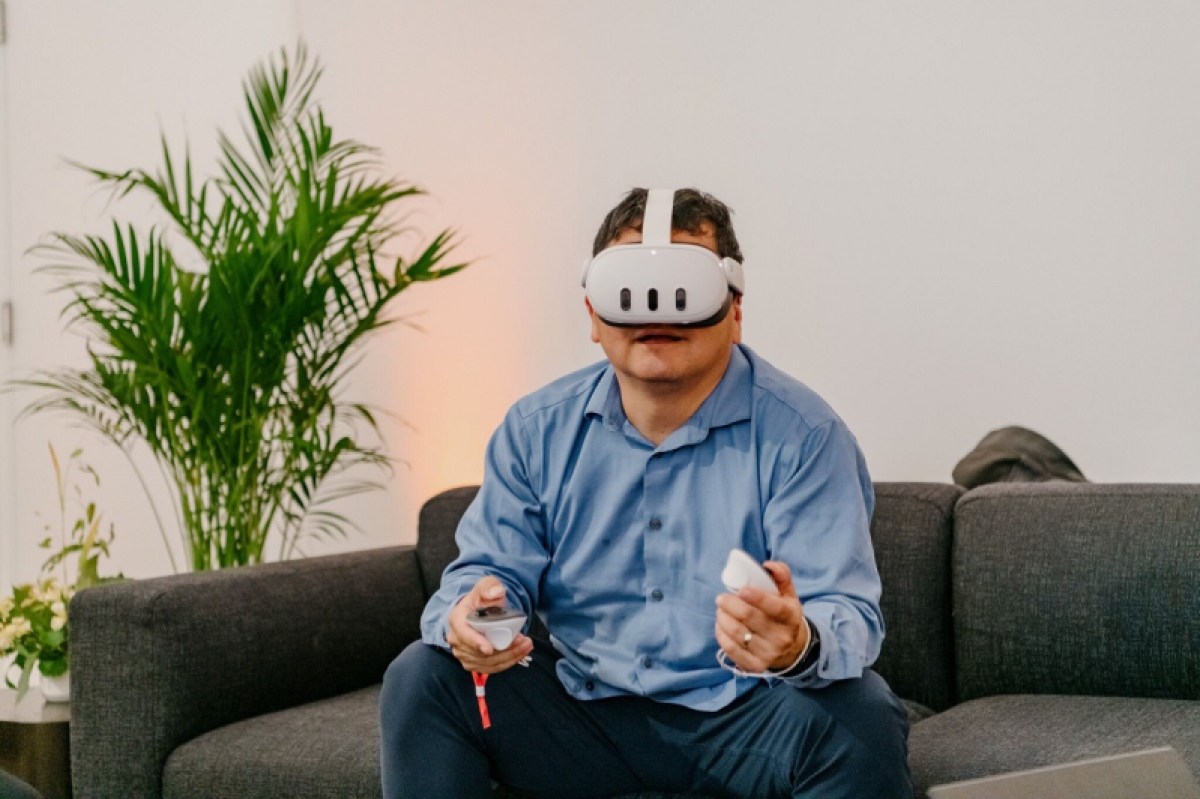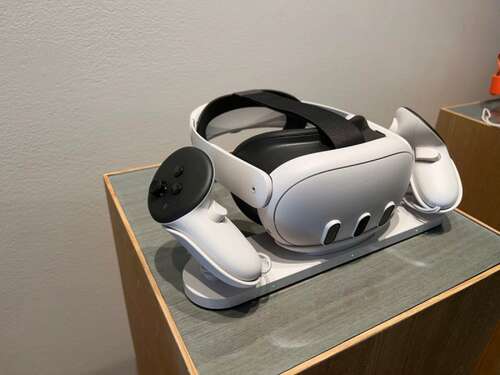Avi-Bar Zeev has been designing virtual reality experiences for so long, he was involved in the first technical discussions around creating the Metaverse back in the 1990s at an early VR startup in Seattle, alongside Snow Crash author Neal Stephenson himself. Bar-Zeev’s expertise culminated most recently at Apple, where he was Senior Manager of Experience Prototyping for the Vision Pro.
No longer at Apple, he is now calling on companies in the XR industry to do something remarkable and unprecedented, because it largely remains a taboo topic: Reveal just how much their devices cause people to become nauseous in various headsets like the Quest 3 and Apple Vision Pro.
“We’d like to know,” as Avi announced recently on his LinkedIn, “what segments of the human population (especially by gender) are nauseated by what kinds of actions in each: e.g., sitting and working, watching movies, walking around 1:1 with reality, moving virtually but not physically.” (Emphasis mine.)
While many tech companies have surely conducted internal studies on this question, he went on, “It would be great to settle the debate publicly.” He estimates up to three-fourths of the population potentially experience nausea in an XR experience.
GB Event
GamesBeat Summit Call for Speakers
We’re thrilled to open our call for speakers to our flagship event, GamesBeat Summit 2024 hosted in Los Angeles, where we will explore the theme of “Resilience and Adaption”.
Bar-Zeev’s announcement echoed what is, I think, the most shocking discovery from my latest book: from what I can tell, Meta has not conducted any substantial research on whether there’s a gender component to VR nausea. It’s an oversight that continues haunting the industry’s future, including Apple and Vision Pro.
The trouble began with a little-remembered incident in 2014, after Meta — still called Facebook back then — acquired the startup Oculus VR for $2 billion. Shortly after, academic danah boyd (a senior researcher at Microsoft) published an essay, much-discussed back then, proactively entitled: “Is the Oculus Rift sexist?” In it, she recounted what happened when she herself excitedly tried out an early virtual reality room demo:
“I donned a set of goggles and jumped inside. And then I promptly vomited.”

That VR can cause nausea has been known for decades, first observed by Cold War military researchers documenting that reaction among some volunteers testing early flight simulators. The response is often attributed to poor graphics, or how the sensation of motion is displayed in VR.
But what danah discovered went deeper than that.
She found, for instance, that a sex difference related to experiencing 3D was observable in trans people undergoing hormone therapy at a gender clinic in the Netherlands. When taking a steroid hormone akin to testosterone, these patients improved at solving a puzzle requiring them to rotate Tetris-like objects in their minds.
How VR is experienced, in other words, may have a sex/hormonal component that might not be addressable by graphical improvements.
danah boyd is not an obscure researcher, but frequently cited in mainstream media and tech news sites, including VentureBeat. So when she ended her 2014 essay with a call for researchers across Silicon Valley to follow up on her initial findings, I assumed this would immediately happen.
It did not.
Reached while writing Making a Metaverse That Matters, she told me that few if any VR industry members contacted her after the essay was published.
Neither did they even follow up with her in 2017, when a study published in Experimental Brain Research found that when women volunteers played a game in an Oculus VR headset, 78 percent of them experienced nausea.
“To my knowledge,” she told me, “[Oculus and Meta] did not pursue any of those research questions.”
Over the years, I’ve asked several senior Meta staffers about this, and have received no adequate reply.
After reviewing the Experimental Brain Research report, I contacted video game pioneer John Carmack — Oculus’ CTO back then — asking if the company had tested its product by sex, to explore the issues danah boyd and others had raised. He wasn’t sure.
“I’m not involved with any of our user studies,” Carmack told me, “So I don’t have any insight there.” He pointed me to Oculus’ PR department, but my question yielded no response from them either.

I asked Meta again in 2022 — sending the question directly to the PR team that handles interview requests for Mark Zuckerberg and CTO Andrew Bosworth — but the steadfast silence continued. (Another follow-up e-mail to them last week while preparing this post for VentureBeat also received no reply.)
To date, my only direct response to this question from someone associated with Meta has been from Cory Ondrejka, a veteran engineer and co-founder of the virtual world Second Life, who was a VP at Facebook back in 2014, where he led the social network’s move to acquire Oculus.
Ondrejka told me that he knows of no research conducted by Facebook/Meta on this topic — but he’s well aware that VR nausea based on sex differences is still very much a live question.
“I mean, danah’s a friend, so of course I knew about it,” as Ondrejka put it to me recently. “[T]he opportunity for Meta has always been to have a scale of resources to be able to do much deeper research on this question. This is all still such an early moment in VR, there are tons of things we don’t understand about how people react to this. If I was ever in charge of VR stuff again, I would be paying for these studies.” (Ondrejka is no longer with Facebook/Meta.)
I cannot overstress how flummoxing an oversight this is on Meta’s part, and for the tech world as a whole. And yes, that includes Apple — but more on that down the way.
Meta paid $2 billion for a piece of technology intended for a mass consumer market, even though reputable research suggested it tends to make half the population literally vomit.
Heedless, Meta then spent tens of billions more to try and bring VR to the mainstream.
Many other companies in Silicon Valley followed suit, now including Apple, investing tens of billions still further, an entire industry sprung up around it — nearly all of which ignored evidence that the whole enterprise might be built on sand.
VR remains far from a mass market product. Despite a furious marketing push that included a 2022 Super Bowl commercial, Meta’s Quest 2 VR headset has an estimated install base of about 20 million units. That’s significantly smaller than the customer count of leading video game consoles, let alone smartphones. Even more telling, the Wall Street Journal recently reported that 2 in 3 Quest owners don’t actively use their headset — some or many of them, we must suspect, due to subsequent nausea experiences.

Mainstream business and technology news outlets rarely raise this subject, and worse, often obscure the issue by illustrating virtual reality articles with photos of women happily wearing VR headsets.
None of this is to dismiss VR as an industry or a technology, I should emphasize. Virtual reality has many proven, valuable use cases, including physical therapy and training. A small but passionate audience does enjoy using VR for gaming, socialization, and creativity.
If the technology was developed as a niche product with limited but important applications, it would likely be in a much more sustainable state today. Meta would not have spent many billions in the vain hope that VR would evolve into the successor to the smartphone — and Apple would not have to spend billions more to effectively re-launch the entire category.
Which brings me back to Apple’s Vision Pro, which has always been touted as an augmented reality headset, or what the company calls “spatial computing” — a term that was actually coined in the early 90s by Dr. Bob Jacobson, founder of Worldesign, Avi Bar-Zeev’s first industry job out of college, where early work on making the Metaverse first began.
Avi tells me augmented reality, like that offered by Apple Vision Pro, should help address the nausea problem.
“My experience is that AR generally lowers nausea when visual latency is very low,” as he puts it. “To the extent you see the real world, or even a stylized but static version of it, the visuals will tend to match your body’s sensations and expectations. Your body motions are 1:1 with the environment you see. AR that blends in normally with the real environment (shadows, lighting), doesn’t jitter or lag, is in proper focus, and is solid versus transparent where it’s meant to be should ideally nauseate as few people (of any gender as) as possible.”
However, this is only a partial solution. “[E]ven in AR,” as Avi adds, “if the world is very dynamic, buzzing around you, or you’re on a moving vehicle, it can invoke the same problems that VR does.”
In fact, VR pioneer Jeremy Bailenson of Stanford recently led a study showing that a majority of passthrough AR sessions with the Quest 3 caused simulator sickness symptoms.
In a follow-up e-mail, Bailenson pointed me to a study conducted at his Stanford lab showing a gender difference in simulator sickness [.pdf link] and a 2020 study trenchantly titled, “Virtual Reality Is Sexist: But It Does Not Have to Be”. Another less-reported study published last year, from Iowa State University, found that among 150 volunteers playing a VR game, women opted to quit the game twice as often as men, reporting a sickness intensity that was 40% higher.
I continue to wonder if, as danah first researched, there’s an irresolvable hormonal component to this consistently reported reaction.
For the most part however, companies in AR/VR aren’t running similar studies on their own products — or just as concerning, sharing them in public. Hence Avi Bar-Zeev’s call for them to share their data. He’s also recruiting people in the industry to join his non-profit XR Guild, to discuss this and other pressing issues.
“On the point of gender differences, I hope companies can share more open research on this,” Bar-Zeev told me recently.
If they don’t, he adds, “we should assume they’re worried about something, or they just don’t care.”
Wagner James Au is author of Making a Metaverse That Matters: From Snow Crash & Second Life to A Virtual World Worth Fighting For.
VentureBeat’s mission is to be a digital town square for technical decision-makers to gain knowledge about transformative enterprise technology and transact. Discover our Briefings.

